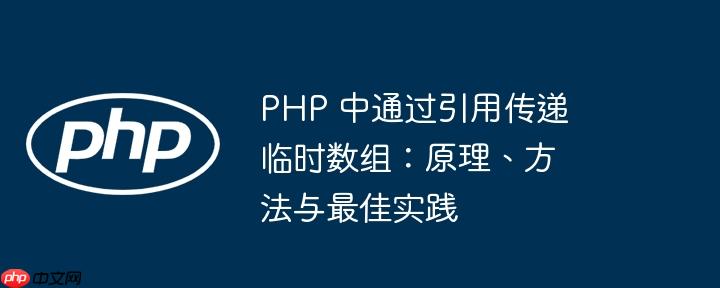
php 中通过引用传递临时数组的限制,解释了为什么直接传递临时数组会导致错误,并提供了一种通过中间函数间接传递临时数组引用的方法。同时,分析了这种做法的适用场景和潜在问题,强调了在实际开发中应优先考虑代码可读性和维护性的原则。
在 PHP 中,函数参数可以通过值传递或引用传递。引用传递允许函数修改传递给它的变量,这在某些情况下非常有用。然而,PHP 对可以进行引用传递的内容有一些限制,特别是关于临时数组。
引用传递的限制
PHP 手册明确指出:只有变量才能通过引用传递。这意味着你不能直接将一个临时数组(例如 [1, 2, 3])作为引用传递给函数。
立即学习“PHP免费学习笔记(深入)”;
以下代码会产生错误:
function pass(&$arr) { // do something } pass([1, 2, 3]); // 错误:Cannot pass parameter 1 by reference
错误信息 “Cannot pass parameter 1 by reference” 清楚地表明了这一限制。这是因为临时数组不是一个持久存在的变量,而是在表达式计算过程中临时创建的。引用需要指向一个明确的内存地址,而临时数组在表达式结束后可能立即被销毁,因此无法安全地进行引用传递。
间接传递临时数组的引用
虽然不能直接传递临时数组的引用,但可以通过一个中间函数来间接实现。这个中间函数的作用是在其作用域内创建一个变量,并将临时数组赋值给它,然后返回该变量的引用。
function pass(&$arr) { // do something $arr[0] = 99; // 修改数组 } function &scopeVar($arr){ return $arr; } pass(scopeVar([1, 2, 3])); $my_array = [1,2,3]; pass($my_array); echo $my_array[0]; // 输出 99
在这个例子中,scopeVar 函数接收一个数组,将其赋值给一个局部变量,并返回该变量的引用。然后,我们将 scopeVar([1, 2, 3]) 的返回值(即局部变量的引用)传递给 pass 函数。这样,pass 函数就可以通过引用修改原始的临时数组。
适用场景和注意事项
尽管这种方法可以实现通过引用传递临时数组的目的,但它并不总是最佳选择。在决定使用这种技术之前,需要仔细考虑以下因素:
- 代码可读性: 使用中间函数可能会使代码更难理解。其他开发人员可能不清楚为什么需要这个额外的函数。
- 维护性: 这种方法可能会增加代码的复杂性,使维护变得更加困难。
- 性能: 创建和传递中间变量可能会带来轻微的性能开销。
在大多数情况下,更清晰、更易于维护的代码是更好的选择。例如,如果只需要在函数内部使用数组的值,可以通过值传递来避免引用传递的复杂性。如果需要在函数外部访问修改后的数组,可以从函数返回修改后的数组。
总结
虽然 PHP 允许通过引用传递变量,但它禁止直接传递临时数组的引用。可以使用中间函数来间接实现这个目的,但需要权衡代码可读性、维护性和性能等因素。在实际开发中,应优先考虑编写清晰、易于理解和维护的代码。只有在明确需要通过引用修改临时数组,并且经过仔细评估后,才能考虑使用这种间接传递引用的方法。
记住,良好的代码风格和可维护性通常比一些微小的性能优化更重要。


评论(已关闭)
评论已关闭